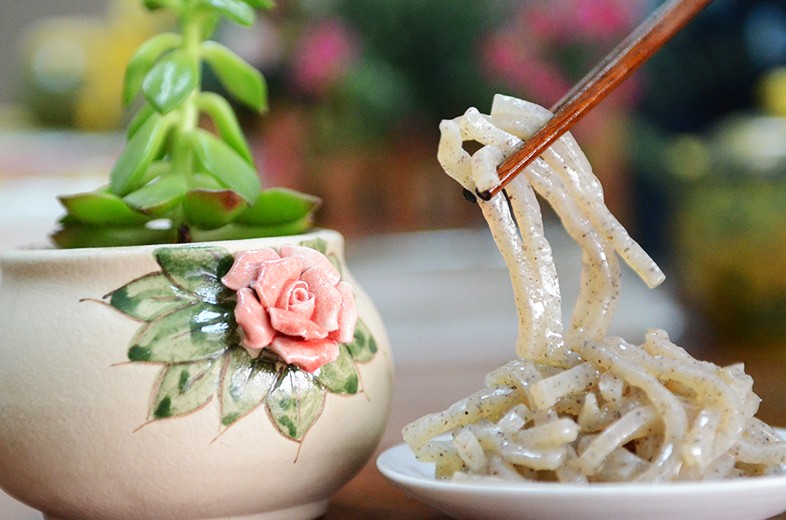
Konjak cleaning is an important step in konjak processing. Konjak processing can be processed into direct processed products, grain and oil products, food additives, beverages, comprehensive utilization products, candy cakes, bionic food, etc. It can be seen that konjak is very popular in our life. For konjak processing, I introduced the wet processing before. Today I want to share with you about the dry processing process of konjak.
Raw material sorting: before processing, the raw materials must be manually sorted, and it is appropriate to select konjak with an individual weight of 1.0kg-1.5kg. The raw materials are too small, the maturity of refined powder is not enough, the particles are small, and the viscosity is low; If it is too large, the moisture content will be higher, which will increase the energy consumption of the dryer and affect the yield of refined powder. At the same time, remove the rotten and moldy konjak.
Peeling: konjak should be soaked before cleaning and peeling, so that the hard mud in its edges, bud eyes and grooves is soft and dissolved, and the skin is brittle, so as to facilitate cleaning and peeling. The commonly used cleaning and peeling methods include manual peeling and mechanical peeling.
① Remove the skin manually, use a bamboo scraper or a scraper made of stainless steel to remove the skin at the taro buds and grooves, or use a nylon brush to clean the sediment and skin on the surface of fresh konjak while brushing.
② Mechanical peeling, using the brush installed in the machine to rotate, slides relatively between the cleaned taro balls, so as to achieve the purpose of cleaning and peeling fresh taro. Mechanical peeling is characterized by high efficiency and low cost. The peeling rate and cleaning rate are generally between 85% and 90%. It is difficult to remove the skin at the concave hole on the surface of konjac by mechanical peeling. Therefore, after mechanical peeling, it should be cleaned manually to scrape the skin that has not been removed. Chemical peeling can also be used for peeling.
Chemical peeling is to put the cleaned konjak tubers into sodium hydroxide solution (containing 0.5% glucomannan solvent) with a temperature of 60 ℃ - 95 ℃ and a concentration of 5% - 15%, soak them for 5min-15min, and then take them out, wash them with water, and the outer skin will be completely removed.
Slicing: the peeled konjak is sliced into slices and strips for drying. The microtome adopts a reciprocating microtome, which
It can realize continuous automatic feeding, uniform size of taro chips, strong adaptability to konjak of different sizes, and easy to match with the dryer. Centrifugal rotary slicing machine can also be used. This type of machine requires manual feeding. There are many broken materials, which are easy to cause sticking and blocking. If the conditions are poor, it can also be sliced manually.
Color fixing: serious oxidative browning will occur if konjak is not processed immediately after peeling and slicing. Therefore, Amorphophallus konjak should be treated with color fixing and antioxidant treatment after slicing and before drying, and the active enzymes should be passivated in order to protect the color and ensure the product quality. In actual production, sulfur dioxide fumigation is often used to control browning.
Drying: the drying curve of konjak chips is complex. The drying process needs to go through three sections of high, medium and low temperature for drying, and the moisture content of the finished product is 13%. Cleaning and grading: in order to ensure the quality of konjak flour, the dried taro chips from the dryer must be separated into laminations, browning chips and unqualified chips that are not cleaned after peeling, and graded. Crushing and grinding: the dry taro chips are sent to the refined flour machine, and the taro chips are crushed and ground, so that the impurities such as starch and cellulose on the surface of refined powder particles are stripped and crushed, and the refined powder particles are not easy to be broken and retained. The processing equipment mainly adopts the crushing and grinding type refined powder machine, which produces konjak refined powder with good quality.
Separation: after crushing and grinding, the mixed powder is transported by airflow and graded to separate the very fine impurities such as starch and fiber, and the coarse refined powder remains.
Screening: screen the coarse refined powder with a vibrating screen to remove a small amount of tubers with large shape, epidermal fragments, large refined powder particles that do not meet the requirements and a small amount of refined powder.









